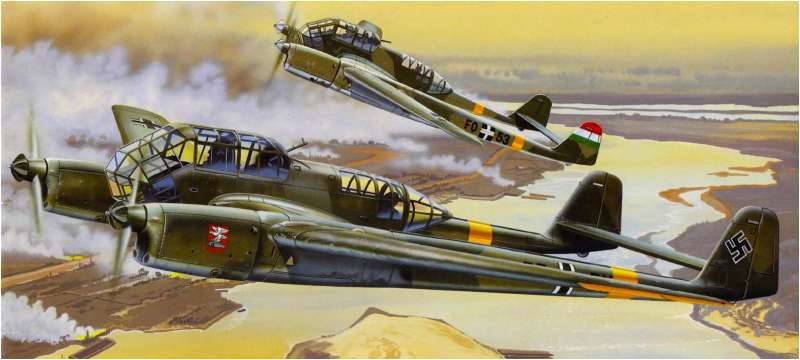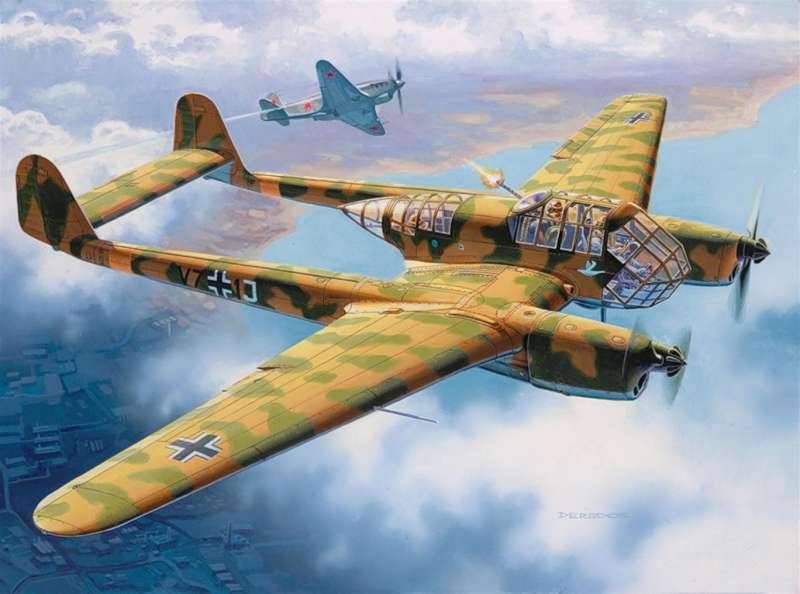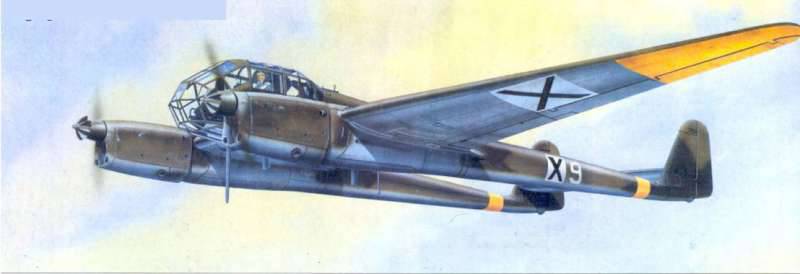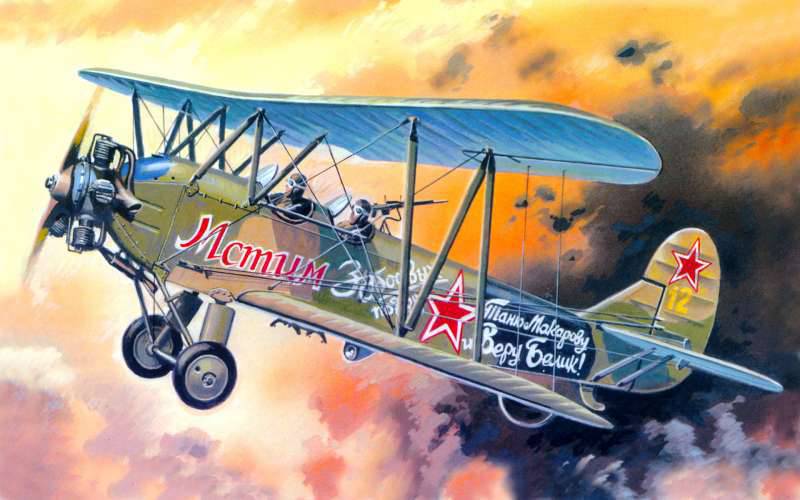The most hated German plane for the Soviet infantry, or again about the FW-189
In the Russian literature, Fw-189 is referred to as a scout, spotter, gun driver, and “battlefield aircraft”, but this aircraft was classified by the Germans only as “nahauf klärungs flug zeug” (“tactical reconnaissance aircraft”) and belonged to the same class together with machines such as, for example, Henschel Hs-126, Hs-123, Fizeler Fi-156. True, according to its characteristics, he occupied a certain intermediate position between them and the category of “long-range high-altitude reconnaissance and high-speed bombers” (which included such machines as Ju-88, Ju-188, etc.).
A pair of Fw-189 from the Hungarian Air Force and from the Luftwaffe units in the camouflage of the Eastern Front of the early war period
Also a common misconception is the view of the Fw-189 as some kind of Luftwaffe super-airplane. In fact, this stereotype was formed due to three factors.
First, the veterans of the Red Army who survived the war simply did not remember the other, even more primitive tactical intelligence officers used by the Germans in 1941-1942.
Secondly, more effective and almost invulnerable to the Soviet fighter aviation other types of high-speed reconnaissance, mainly used by the Germans in 1943-1945, were hardly noticeable and difficult to recognize even for pilots, not like for ground forces. As a result of this, in the memoirs of our veterans, these types of Luftwaffe planes are mentioned only as “a German scout flew in the sky” or “German planes that scouted high above us”, etc. While the very characteristic silhouette of the “frame”, which mainly worked at low and medium heights, was clearly visible and easily recognizable.
Thirdly, the Soviet pilots, especially in 1941-1943, because of their (largely) poorly trained training, began to consider the Fw-189 a kind of honorary trophy and also contributed to the creation of the stereotype that the “frame” was then a super-plane. Of course, this is the brainchild of KB prominent German aircraft designer Kurt Tank It was distinguished by the highest survivability, and Soviet fighters in the first half of the war mainly had weak weapons. However, in favor of the opinion that the “frame” was, in general, a reasonably accessible target for a trained pilot, it is evidenced that the Soviet Air Force had 17 aces, on their account there were 4, and two even had 5 shot down Fw -189.
And even despite the fact that since 1943, many of the Fw-189 were withdrawn by the Germans from the front line or transferred to the allies, appearing on the Soviet-German front "frame" even in 1944-1945. continued to be considered exemplary trophies (for example, the great Soviet ace Alexander Pokryshkin said that the pilot who shot down Fw-189, as it were, passed a sort of exam for flight skills). However, starting from the spring-summer of 1943, the leadership of the Luftwaffe, focusing on the increased combat effectiveness of the Soviet air force, decided to abandon any low-speed tactical reconnaissance and light attack aircraft in the front line units, transferring them to the rear and using them as airplanes and for anti-partisan actions. At the same time, the basis of the front-line intelligence officers of Germany in the 1943-45. began to make high-altitude high-speed vehicles, the best modifications of which at high speeds, good rate of climb and a large practical ceiling (far exceeding in this Fw189) became extremely difficult targets for the Red Army Air Force. Therefore, the Soviet pilots, in fact, even the entire second half of the war still continued to hunt for rare enough on the front lines, but remaining the same low-altitude and slow-moving “frames”.
By the way, lovers of military equipment of the Second World War will be interested in the little-known fact that at the present time there is only one instance of Fw-189 in the world that carries out real flights. This machine, while carrying out a reconnaissance mission in the Soviet Arctic, was attacked by a group of Hurricanes on 4 on May 1943 of the year. And, although the plane received many holes, and one crew member was killed, the German pilots were still able to get away from their pursuers. True, it was not very far to leave - because of the failure of a number of systems, the crew was forced to make an emergency landing in the tundra, in which another crew member died, and the first pilot was injured (the damaged plane was going at a low altitude, he could no longer climb, and, accordingly, the crew did not have the opportunity to jump with parachutes). The surviving pilot was named Lothar Mothes. He avoided being caught by Soviet patrols and in two weeks, eating only berries and mushrooms, could still reach the German positions; He was placed in the hospital and after a few months he resumed his combat missions.
In 1991, his plane was found by the Russian-English search engine community and transferred to the UK for recovery. Over the course of several years, this Fw-189 was reconstructed and in 1996, the heavily aged, but war-surviving Lothar Motyes again sat at the helm of his own fighting vehicle (it was not the aircraft of the same type, but his own that flew). stories technology of the Second World War. Since then, this Fw-189, brought to a flightable state, periodically participates in historical airshows in the UK.
Now we will consider a question on quantity of the made cars of this type. Here the situation with the "frame" is very similar to the stories of some veterans and modern journalists, according to which almost any large German tank turns out to be a "Tiger", and any self-propelled guns - "Ferdinand", because, judging by the memoirs of Soviet front-line soldiers, the Germans were just thousands of Fw-189, literally constantly filling the sky and there were no other aerial reconnaissance aircraft. However, in reality, the situation was completely different: the cumulative figure of all built Fw-189 - 864 units, of which 830 are serial units, i.e. The “frame” was quite a medium-sized car (for example, the same “JU-87” laptezhnikov ”built at least 5709 units, and all types of Ju-88 of all types produced more than 15000).
And that, probably, will also seem surprising to the Russian reader, so this is what the Germans never considered the “frame” to be an outstanding aircraft, since they really had outstanding machines in abundance (for example, the same Messershmidt Me-262 and Arado Ar-234 ). The fact that the Fw-189 was a kind of "gray workhorse" is evidenced by the fact that the production facilities of the Focke-Wulf factory in Bremen, where the "frames" were originally made, in the middle of the war, it was decided to release for the production of "really necessary »Other types of aircraft. The assembly of Fw-189 was continued at two plants located not even in Germany, but in the territory of other countries - “Aero Vodochody” near Prague (still existing concern, known by such machines as, for example, L-39 and L-139 ) and at the Avions Marcel Bloch enterprise near Bordeaux (the future concern Dassault Aviation, which produced the famous Rafale fighters). Accordingly, in the Bogemia protectorate in 1940-1944. At least 337 was produced, and in Vichy France - 293 Fw-189, not counting non-serial samples.
Moreover, the Germans themselves believed that technically it was outdated by the beginning of the 1940-s aircraft, and this despite the fact that its serial production began in the year 1940. In fact, they released Fw-189 in 1940-1942. mostly forced, because more advanced types of air reconnaissance were at the stage of bringing to production. And exactly the same opinion was the Soviet delegation, which visited Germany as an ally of the USSR with the aim of purchasing new weapons in 1939. Paradoxically, but the Soviet technical representatives of Fw-189 were not interested in anything, except for an unusual design, and the Soviet test pilots "coolly" reacted to the "frame" on which they carried out test flights. As a result, thanks to such a serious underestimation of this machine, after World War II, some Soviet commanders, for example, Marshal Ivan Konev, could only complain that "throughout the war, our army did not have a single aircraft similar to the German Fw- 189.
And again we see a paradox: the Fw-189 (like the same Ju-87), a rather modest airplane in terms of flight data, but actively interacting with ground forces and easily recognizable by the enemy, becomes a characteristic “military brand”, while the more effective , faster and less vulnerable models remain in its shadow.
Having considered the issue of production, we turn to the issue of the combat use of the "frame". He is not as banal as it seems. Firstly, one of the common misconceptions is that Fw-189 was used only on the Soviet-German front, and only as a close reconnaissance aircraft. However, as long as the combat situation allowed, in 1941-1942. Several squadrons of the Fw-189 were actively used in parts of the Luftwaffe in the North African theater. For actions in North Africa, even the special “tropical” type Fw-189 Trop was created, equipped with anti-dust filters, special cabin light protection and a special unit for drinking water. However, after the Western allies seized air supremacy over North Africa and defeated the Axis forces near El Alamein in the autumn of 1942, and then the surrender of their armies in Tunisia in the spring of 1943 in Fw-189 in the Mediterranean. At the same time, this rather low-speed (max. Speed 350-430 km / h) and low-altitude (maximum practical ceiling 7000 m) machine was clearly not suitable for operations in Western European theaters.
However, their service on the Eastern Front, where initially the Red Army Air Forces were not sufficiently effective, was much longer. In general, however strange it may seem to the Russian reader, as of 22 June 1941, in parts of the German Air Force involved in Operation Barbarossa, there really wasn’t a single “frame”. But in November 1941, the first batch of Fw-189 was redeployed to act against the Red Army, and since December 1941, this aircraft has gradually become the main tactical reconnaissance officer of the Eastern Front. In the 1941 year, relying on the wishes from the front, they are created in the Kurt Tank Design Bureau, and in the 1942 year they are introduced into the series of modifications of the “frame” as a light attack aircraft with various types of reinforced weapons (they usually replaced two 20-mm guns in them) but there were other modifications). In addition to changes in the set of weapons, cockpit and main aircraft units in assault modifications covered armor, although this did not improve the already very mediocre flight data Fw-189.
It should be noted that the increase in the combat effectiveness of the Soviet Air Force in 1942-1943. primarily affected the most slow-moving German aircraft, and as already noted, since the summer of 1943, the “frames” are mainly reoriented towards fighting the partisans (which they successfully conducted in 1943-1944) not only in the occupied part of the USSR, but also in the territories of Yugoslavia and France). In this functional role, Fw-189 also proved to be as successful as earlier as a day-to-day tactical reconnaissance, primarily due to the absence of allied high-speed fighters in the rear areas and very weak anti-aircraft partisan equipment.
Fw-189 in autumn camouflage is fighting with Soviet fighters
In addition, some of the Fw-189 was transferred to the satellite countries of Germany: 14 machines were transferred to the Slovak Air Force; 16 machines were transferred to the Bulgarian Air Force; minimum 30 vehicles entered the Hungarian Air Force; several dozen aircraft entered the Romanian Air Force.
And according to practically unanimous reviews of pilots of these countries, the Fw-189 was a fairly stable and very tenacious aircraft, with an excellent overview and excellent navigation devices, the shortcomings of which were low speed and insufficient climb. And, however surprising it may seem again, but despite the small number of aircraft transferred by the Reich to their satellites, it was on the Eastern Front as part of the above-mentioned countries that they were able to successfully complete the war before they left the war (which indirectly confirms that Soviet fighter pilots even in the 1944-45 years nevertheless continued to remain fairly average qualifications). And the last sortie of the "frame" was generally carried out on the Eastern Front 8 of May 1945, when, it would seem, there should be no longer any conditions for its use ...
We have not yet considered all the options for the combat use of such a fairly versatile machine as the Fw-189. And although, in the opinion of the Soviet side, the “frame” produced the greatest impression as a neighbor intelligence officer, the Germans assessed his merit in this capacity rather meagerly, since for the second half of the war, the Luftwaffe had more efficient aircraft for this purpose. However, one of the main areas of its combat use, along with anti-partisan actions, in the second half of the Second World War was its use as a night air defense fighter.
Now let's try to dispel the misconception about the unofficial nicknames Fw-189. Of course, the Soviet soldiers called him "frame" ("crutch" - it was the nickname of other tactical intelligence officers, such as Hs-1265, Hs-123, Fi-156, which was "inherited" by Fw-189). In the Wehrmacht, Fw-189 was usually called the “flying eye” (however, it was the universal nickname for all reconnaissance aircraft). However, with the 1942-1943, with the transition of this aircraft to the night air defense missions, the nickname “owl” stuck to it. In Russian, the name of this bird does not have any ominous shades, in German its name “uhu” simply imitates the frightening cry of an owl, but, for example, in English the owl is called “eagle-owl” - “eagle-owl”, which emphasizes the predatory the nature of this bird.
By the way, it should be said that another German air defense aircraft also wore the nickname “eagle owl” - this was Heinkel He-219, a truly terrifying killer machine in the hands of an experienced pilot, much more effective as a “night hunter” than Fw-189 (although fortunately for the Allies, they were made smaller in 3 than even Fw-189, there are only 268 units, and the Germans did not use them on the Eastern Front).
It is also worth noting such a little-known fact, like the fact that in 1940-1942's. “Frame” was used as a “flying headquarters” by a number of Wehrmacht generals for personal reconnaissance of enemy positions. True, with the 1943 of the year, the top officers in Germany no longer took such a risk, using more advanced types of aircraft. In the spring of 1944 of the year, the Luftwaffe leadership issued a special circular that specifically prohibited the use of Fw-189 during the day in the front line, even with strong fighter cover.
Of course, due to the low speed and medium altitude, the “frame” turned out to be a mediocre night fighter of German air defense, but on the Eastern front in this capacity Fw-189 showed itself to the full. The fact is that before the war in the USSR several thousand small U-2 (Po-2) airplanes were built, used mainly as training machines (more than 33000 were produced, this was the second most massive Soviet war plane after IL-2). After a considerable part of them died in the summer of 1941 in the course of attempts to use this aircraft during the daytime storming of enemy columns, from autumn-winter 1941, Po-2 was transferred to the role of a night bomber, often with female pilots. That was the beginning of the famous night witch shelves. And precisely as a “night hunter” on light bombers, Fw-189, according to German estimates, showed itself very well. The first steps in this direction were made in the 1942 year, but the Fw-189 in the variant of the night air defense fighter began to be used en masse from the summer-autumn 1943.
Strange as it may seem, when describing the combat activities of the Po-2, Russian authors usually say nothing about the adequate response of the Luftwaffe to the massive night raids of light bombers. The fact is that since the 1942, the Germans have formed special “Stor kamf staffel” (“Battle Squadrons of Persecutors”) out of obsolete types of aircraft (mainly biplanes), which became ineffective in day operations and whose “night hunt for flying witch ". This squadron initially included the Fw-189 part. Later, from 1943, the “night hunters” of the Fw-189 were consolidated into their own special units, the Nahauf klarungs gruppe and the Nacht jagd gruppe, which they were used to until the end of the war.
As it turned out, the disadvantages of the “frame” in this role turned out to be advantages: excellent maneuverability and excellent visibility were successfully complemented by good stability in flight at all height ranges, including supersmall ones, and the possibility of flying at low speeds. The Fw-189 version of the “night hunter” version was equipped with a radar, a high-precision radio altimeter, weapons were added, and the “frames” converted in this way not only turned out to be an enemy of the Soviet infantry, but also the main killer of the Soviet “night witches” altitudes - this is the lack of altitude for parachuting, and therefore our girls pilots often did not even take a parachute with them to facilitate the aircraft).
Fw-189 Bulgarian Air Force on the Eastern Front
Combat use of the "frame" as a night fighter on the Eastern Front was carried out as follows.
1. When the Wehrmacht became aware that regiments of Soviet night light bombers were operating in this sector, a “squadron of nighttime pursuers” was called up, who had previously taken off at night to hunt. The Wehrmacht and air defense units were instructed not to use anti-aircraft guns and a searchlight, so as not to blind their aircraft and not accidentally knock down their own.
2. The German ground-based air defense systems detected and transmitted the direction of passage through the front line of the Po-2 group. Having received this information, Fw-189, already on duty in the air, such quiet "eagles-night owls", began to sneak up to the usually unseen Soviet pilots (who were blinded by the spark of their motor in the night mist, and the sound of foreign motors drowned out the sound of their own "coffee mill ").
3. It is possible that the Po-2 pilots, not seeing the lights of the searchlights and the work of the anti-aircraft guns, even calmed down, assuming that they were not noticed, and they successfully passed the front line. But the whole horror of the situation was that they were just noticed and night fighters opened their hunt for them. At the beginning, Fw-189 intercepted the Po-2 group with an airborne radar (sometimes even 2 radars working in different ranges were put on the “frame”), then visually and then attacked, often with almost no noise, in the planning. And of course, you can imagine what the Poe-2 did with the poor X-guns or four machine guns. Indeed, it can be said that such a method of attack caused an absolutely clear association with the eagle owl's night hunt.
By the way, the fact that the crew of Fw-189 consisted of three people, while working in the cockpit as a single team, in clear interaction with ground units, and having excellent equipment, played a very important role in detecting the target. At the same time, the pilot and the observer on the Po-2 sometimes just did not even hear each other, having the most primitive navigation equipment (and the pilots of light night bombers simply could not even dream of on-board radars).
And, probably, it is worth noting a very important point: the author never once mentioned in the reminiscences of the Soviet “night-maidens” who survived the war the Fw-189 attacks. This is simply an amazing fact, which testifies to the fact that, perhaps, our “light bombers”, our “light bombers”, actually did not really know the whole war! Although this is easily explained: apparently, those who have already seen the eagle owl attacking them in the darkness of the night could no longer tell anything more about it, and their partners thought that, apparently, their anti-aircraft guns shot down their friends. Some, apparently, thought that they were attacked by night Me-109s or described by some other types of Luftwaffe planes ... In general, one way or another, it was precisely in the role of the "night hunter" that Fw-189 turned out to be very effective exactly when he was almost unable to function as a day scout.
Light bomber Po-2 (Y-2) in battle
We now turn to the issue of losses Fw-189. The fact is that only Soviet pilots, and only fighter aircraft pilots, 795 claimed victories over Fw-189. Theoretically, it would seem possible, but then to the share of losses of the Reich air defense, North Africa, the "night hunters" of the Eastern Front, and most importantly, the losses from anti-aircraft fire from the ground and non-combat operational losses (which often amounted to 40% and even more from aircraft produced), there are only 60 aircraft, which is absolutely unrealistic, and therefore the issue requires further study.
At the end of our article, we will explain another myth about the “frame”: it is sometimes said that the Soviet pilot who shot down the “frame” was allegedly given an order. In fact, this was not (perhaps with some very rare exception), but almost always in the air regiment, where a successful fighter served, after the battle came a delegate from infantry formations, over which the shot down frame hung, and always handed the pilot a sincere thanks (mostly liquid) for the care of ground forces.




Information